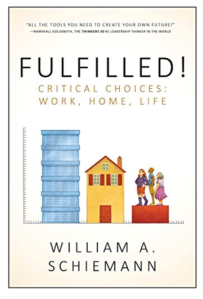
I rarely do book reviews here at Data Point Tuesday. When I do, it’s because the book is written specifically for my readers, HR professionals in the trenches, and because I know and respect the author. Today I’d like to recommend just such a book.
 Fulfilled! Critical Choices: Work, Home, Life, written by William A. Schiemann, will be available on October 1. Lucky me, I got an advance copy and loved it! If you’re active in SHRM, then you have probably heard Bill speak at the Annual conference or at one of many state conferences where he continuously supports the HR profession. I saw Bill two weeks ago at the KYSHRM conference where we both keynoted. He’s a Ph.D. researcher, writer and consultant bringing evidence-based research into practical and useful focus for organizations of all types and sizes.
Fulfilled! Critical Choices: Work, Home, Life, written by William A. Schiemann, will be available on October 1. Lucky me, I got an advance copy and loved it! If you’re active in SHRM, then you have probably heard Bill speak at the Annual conference or at one of many state conferences where he continuously supports the HR profession. I saw Bill two weeks ago at the KYSHRM conference where we both keynoted. He’s a Ph.D. researcher, writer and consultant bringing evidence-based research into practical and useful focus for organizations of all types and sizes.
Fulfilled! Is a guidebook as well as a workbook – it helps you organize and chart the steps to find meaning in your life and your work, as well as supporting your organization in creating a culture where every employee can find that meaning. It’s full of true individual examples of people achieving real meaning as well as examples of people who missed the waypoints along the way and never achieved true fulfillment.
From an organizational perspective the organizing concept is ACE: alignment, capability and engagement, which Bill calls “People Equity.” Bill’s consulting firm, Metrus Group, has found that organizations with high People Equity have:
- Higher profits or reach their goals more effectively
- More loyal customers who buy more
- High employee retention
- Higher quality output
“The organizations that achieve high People Equity (high alignment, capabilities, and engagement) have a distinct advantage over their competitors. And the individuals who apply this concept to their live also win…”
I really appreciated both the individual and organizational discussions about alignment, capabilities and engagement. They are simple and easily understood – and so impactful. This is one “How-To” book that ought to be on every HR leader’s bookshelf.
I don’t want to give away the good stuff – the book is available on Amazon on October 1 and you should get it. But here’s a final view at the final chapters of the book, Life Lessons:
Lesson 1: Keep the end in mind
Lesson 2: Nurture your body
Lesson 3: Build a social network (but have at least one fantastic friend)
Lesson 4: Always seek things you are passionate about
Lesson 5: Take reasonable risks
Lesson 6: Never stop learning – never!
Lesson 7: Stick to your values and spirituality
Lesson 8: Resilience – find the silver lining
Lesson 9: Give and get
Lesson 10: Check in with yourself regularly – force it!
You may think to yourself, I’ve read this book before. But I assure you, you haven’t. Bill brings to life real people who made good decisions as well as mistakes; who risked it all and who played it safe; who learned and who never learned. And the organizing principle of People Equity is truly a new view backed by years of research and real life practice.
And after you’ve read Fullfilled!, take it with you to your next HR conference. Chances are good that Bill will be keynoting and you can get him to autograph it for you!






